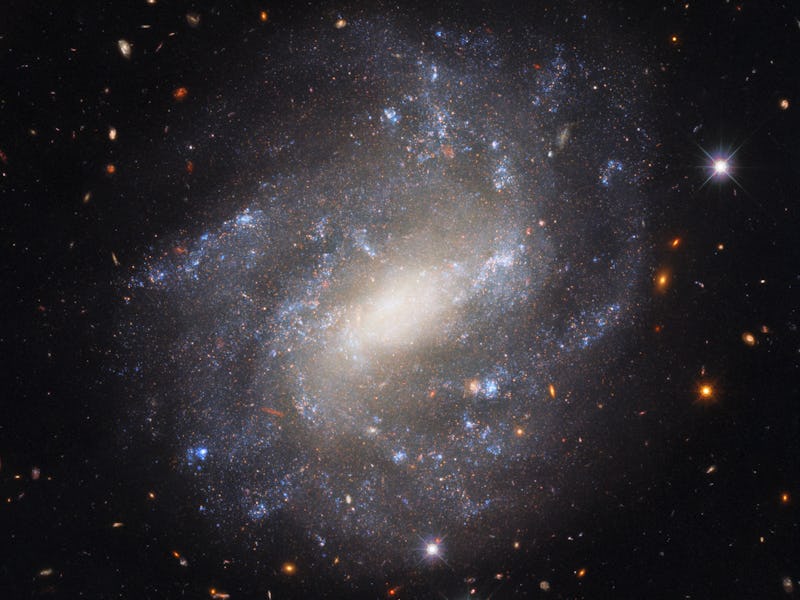Hubble spotted a breathtaking spiral galaxy that holds clues about the fate of the universe
The Hubble Space Telescope recently imaged spiral galaxy NGC 9391, helping astronomers measure cosmic distances more precisely.

This spiral galaxy isn’t just pretty — although it’s definitely that. The star system is also a benchmark for measuring the immensity of space.
Spiral galaxy UCG 9391 takes center stage in this stunning image from the Hubble Space Telescope, but the most dramatic part of the scene is the distance between the stars in the foreground and the galaxies in the background. Bright diffraction spikes mark luminous nearby stars, while mind-bogglingly distant galaxies range from tiny spirals to faint pinpricks of light. Imagine the immensity of a galaxy of hundreds of billions of stars; how far away must that galaxy be to appear as a single dot of light in the distance?
The galaxy at the heart of this image is helping astronomers answer that question more precisely.
UGC 9391 is about the size of the Large Magellanic Cloud, one of the dwarf galaxies that orbits our Milky Way, but unlike many dwarf galaxies, UGC 9391 isn’t part of a galaxy cluster or group. It drifts through space alone.
Astronomers can directly measure the distance to nearby stars — within a few hundred light years of Earth — with some fairly simple math: Measure the angle between the star and the horizon and then repeat the measurement 6 months later when Earth has completed half an orbit around the Sun. (We know the diameter of Earth’s orbit, it’s roughly 300 million kilometers. In other words, you have the length of one side and the angle of two corners of a triangle. The rest is just math.)
For slightly more distant stars, color is a good clue. The color of a star’s light is coordinated with how bright the star actually is, which astronomers call its luminosity. But how bright the star appears depends on how far away it is, so astronomers can measure a star’s color and how bright it looks from Earth, then use the difference to figure out the distance to the star.
Astronomers use a different version of the luminosity versus brightness trick to measure the distance to even more far-flung objects, like distant galaxies. But for that, they need objects — called standard candles — whose luminosity astronomers know or can calculate. Two of the best standard candles are type 1a supernovae (which happen when a white dwarf star, in a binary star system, accretes so much material from its partner that it explodes) as well as stars called cepheid variables. A cepheid variable star brightens and dims at regular intervals, and the length of those intervals is directly related to the star’s luminosity.
Recently, astronomers studying spiral galaxy UGC 9391, pictured in this new Hubble image, were able to compare the distances they calculated using supernovae and cepheid variables. By spotting shifts in results from the two methods, astronomers can work on making their cosmic distance measurements more precise.
Knowing the precise distance between two objects in space is incredibly important, as it can help physicists figure out how fast the universe is expanding. Importantly, that could tell us what fate eventually awaits the universe and everything in it. We know the universe is still expanding 13.8 billion years after the Big Bang, but how fast that’s happening, and whether it’s speeding up or slowing down, will inform us of many crucial details. For one, it will reveal whether we have enough thermal energy for the universe to keep expanding (heat death), if the universe is about to rip itself apart, or if it will fall back into itself rather than continue expanding (big crunch).
And thanks to a dwarf galaxy about 130 million light-years away, we’re a small step closer to getting answers.